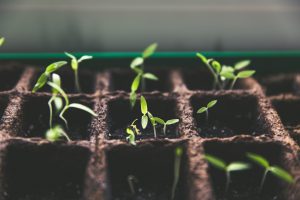 When it comes to growing and gardening many seem to think they lack that certain something to be good with plants or that they need a sprawling property to cultivate a garden.
When it comes to growing and gardening many seem to think they lack that certain something to be good with plants or that they need a sprawling property to cultivate a garden.
Please throw those misconceptions aside. A sunlit windowsill, balcony, patio, porch, or yard can all help you bring some life and healthy goodness into your world, improve your views, as well as save you some money and trips to the grocery store right now.
There are many types of gardens, however we’re going to concentrate on an edible one, and despite common knowledge, there’s a multitude of herbs, fruits and vegetables that you can grow indoors; some even by re-growing end cuts or pits like romaine lettuce, celery, carrots, pineapple, tomatoes, peppers, garlic, avocado and much more. Yes, the needs of each plant vary slightly, but they all come with instructions, and they all require the same core essentials: appropriate lighting, watering and soil conditions.
So, before you go and purchase anything, get to know your planting space. Understand its dimensions (width, depth and height for taller plants), and the type of soil you have (if not purchasing packaged soil) by doing an easy soil test. You should also pay attention to your hardiness zone, as well as where, when and how light falls on your planting space. Whether indoors or out, this will alter slightly throughout the year because of the height of the sun and casting shadows from neighboring objects or vegetation as it fills in or dies off with the seasons. Ideally you want a spot with full sun to minimal shade.
The great indoors
If condo living is your thing or you don’t have outdoor access, growing indoors is super easy, if not easier some might say. All you need are good pots with drainage holes/plates for indoor gardening, a good potting soil, and the right seeds. You’ll want a store-bought soil mixture to ensure you’re not bringing in any unwanted guests from outside. Drainage holes help ensure you don’t over saturate roots, and depending on what you’re growing, you may need a misting spray bottle, support sticks, and twine (to secure stems). Here are some of the best plants for indoor growing, you can also try garlic, beets, dwarf beans, English peas, avocados, potatoes and mushrooms. Our increased indoor lifestyle has created a resurgence in hydroponic farming, so for those with loftier goals of higher yields, there are pricier hydroponic solutions available. Do be warned though, as these cost more at the checkout and on utility bills.
Bridging the gap
If you live in a downtown core where you have access to a small outdoor space like a porch, patio, balcony or small yard the same rules apply to you as to indoor-only growers, you simply have more space to play with. In fact urban building landscapes have generated a chic outdoor living space movement, with a plethora of design ideas based on thinking outside the plot. Here your focus is on container gardening or square foot gardening, in a well-lit area, taking extra advantage of vertical growing options or garden designs.
Green Acres
The unfortunate truth is that not everyone has a wonderful yard to take advantage of, but if you do, now is your time to make the most of it. The zone you live in will dictate when you can start planting outdoors and what. For cooler, seasonal climates, get your seedling kit started now or plant directly from store ordered seedlings when safe. You have the choice of digging directly into the ground (be sure to test your soil) or building raised beds. Either way be sure to check with local conservation groups to seek out varieties that are native to your area and be wary of well-intentioned choices you make that are also considered invasive species. You may experience more animal competition outdoors, but you’ll notice a marked difference in how large your garden becomes with room to grow.
The thought of getting one’s hands dirty isn’t something that many seem to enjoy anymore, and that’s no dig, but the simple truth of the matter is for indoor or inner city gardeners, it’s not all that dirty. Nurturing a plant is a relationship at its most basic, and just as is the case with people, once you find out a plant’s needs you realize it has much more to do with paying attention than the color of your thumb.
Written by Melanie Robitaille


